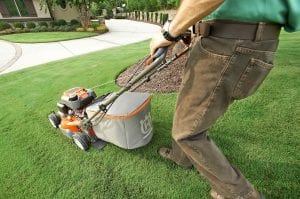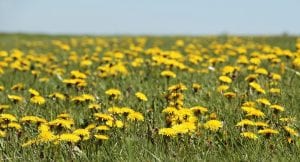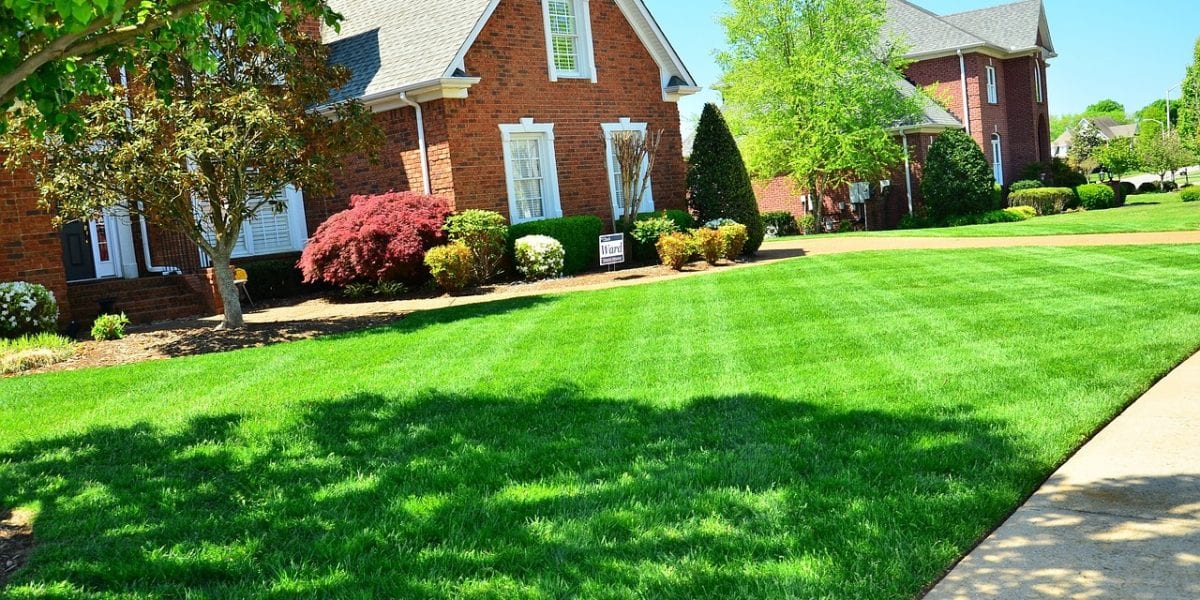With all the pesticide ban laws in play the world becoming more aware of what exactly we are (were) putting on our lawns and, in our soil. There has been a big push for ‘Organic Lawn Care’.
Organic Lawn Care, what is it? What defines organic? I am sure a lot of readers have a basic understanding of what organic means, but do you know how to apply the term to your lawn? We hope that by reading this article you come away with some proven information and put them into practice.
Organic Lawn Care
A Natural Approach
Organic Lawn Care is a series of practices when put into place can create a lush, dense lawn that is less susceptible to weeds and more resistant to insect pests and disease. Something that we are all looking for at the end of the day. I have yet to meet someone that says, “Let it go brown and weedy, that’s the way I like it.” So, I hope the following helps a few people out there.
Water Hogs Beware, Your Lawn Doesn’t Thank You
The number one mistake homeowners make when caring for their lawn is over-watering. Water studies suggest that when homeowners must abide by a watering schedule, people apply water several times in short intervals to their lawns. One reason too much water can be harmful to your home lawn is that it creates a perfect environment for diseases. And, ironically, it may increase water consumption. Drought-enforced watering schedules often result in homeowners watering their lawns too much. It is probably one of the most important items in this list to pay attention to. So how do you give your lawn the water it needs without putting out a welcome mat for unwanted diseases?
Lets break it down
Just like the human body, to maintain a healthy lawn, you need to make sure it gets adequate hydration. Your lawn needs 2 inches of water per week. This may increase to 2 inches of water twice per week in hotter climates or drought seasons. By getting down into the soil 2 inches you’ll promote great root structure for your turf. By just dampening the soil or watering your lawn everyday a little bit will only allow the water to just penetrate the soil. This will make for a very shallow root system…exactly what you do not want. Shallow root systems will be susceptible to drought die back, lawn tearing (from your mower or heavy traffic) and insects will be able to mow through your lawn in record timing.
“Well Richard, when is the best time to water my lawn?”
Just before dawn is the best time to water your lawn. This gives your lawn plenty of time to dry during the day. You want to maximize the amount of water consistent with good growth but with the least amount of surface wetness.
“How do you know if you watered 2 inches?”
The easiest way to tell (not the most accurate, but it is a good way to get an idea) is to lay out a few containers and turn on your irrigation/sprinkler system. When you have about 2 inches of water in the container, then you could assume that you have watered 2 inches into the ground. You can also get a water meter that will attach to you water tap and you can monitor the amount of water that goes out. Or perhaps the best and most accurate way is to take soil sample plugs in a few different locations and visually see how far down the moisture is going.
“What’s wrong with watering everyday?”
Not only is it a waste of water and money (water is an increasingly expensive resource), another good reason too much water can be harmful to your lawn is that it creates a perfect environment for pests and diseases. A healthy lawn needs to become dry between watering’s as well. Turf that is allowed to dry will send roots further down into the soil to find new moisture.
Now of course there are exceptions to everything. Golf courses water just about everyday (weather permitting), but they use a very different soil structure then your lawn at home. If your soil for your lawn is compacted, you may experience water runoff or pooling. Therefore, your lawn will not absorb the water it needs and it will most likely evaporate. In this case it is time to aerate.
Mow High and Mow Often
 Maintaining your lawn to 3”-4” and never cutting more than 1/3 of its total height at any one time promotes good root structure and growth. Mowing your lawn too short creates weak and shallow root systems therefore making your lawn susceptible to weeds and disease. The exact things we are trying to avoid.
Maintaining your lawn to 3”-4” and never cutting more than 1/3 of its total height at any one time promotes good root structure and growth. Mowing your lawn too short creates weak and shallow root systems therefore making your lawn susceptible to weeds and disease. The exact things we are trying to avoid.
Make sure to mow your lawn once a week when it is growing actively. In summer, however, once every two weeks is usually enough (depending on circumstances; weather, watering, shade, quality of soil).
Grass clippings in moderation can also be left on the lawn. When they breakdown with the help of micro-organisms in the soil, they release nutrients making your lawn healthier. A mulching mower or blade kit can help with this process. This is an important step for natural lawn care.
And while we are on the topic of mowing, make sure your lawnmower blade(s) are always sharp. Dull blades tear the grass blades rather than cutting them. The results can be ugly. The tips of your grass blades will turn brown/gray giving your lawn a bad finish. If you are not too sure on how to sharpen and balance your mower blades most small engine repair shops will be happy to do that for you.
Improve Your Soil for Natural Lawn Maintenance
By improving your soil quality, you are giving your lawn a nice bed to lay in…or on for that matter. There are many ways to accomplish this and here are a few.
Aerating
Aerating consists of making many small holes in your lawn by removing plugs of soil with a core aerator or by making holes using a pin aerator. These both come in manual and engine devices. The most common aerator you may have seen is the core aerator.
By doing this you allow a better flow of air, water and nutrients to the roots. This stimulates root growth and prevents thatch build-up. You need to aerate when the ground becomes hard and compacted. Compacted lawns will not absorb water and nutrients as well making for a sad lawn. However, weeds seem grow in abundance in compacted soil.
Because aerating creates quite a few openings in the lawn, it is best done from late-August to mid-September, when lawns are less susceptible to weeds and the ground is moist without being drenched. You can also aerate in spring when the ground is cool but not waterlogged. The idea is to allow your lawn to heal from this process. Aerating in the middle of a hot summer is not a good idea.
Topdressing
Compost, compost and more compost. You cannot get a better topdressing than compost. Compost is both the best soil amendment and the best fertilizer. It adds micro-organisms to the soil, giving them both shelter and nutrients, in addition to improving the soil structure, balancing the pH and supplying essential nutrients for plant growth. You should apply a layer of compost once every three or four years in spring or early fall, when the lawn is in active growth.
Compost may be harder to find than other topdressing (black earth, triple mix, screen topsoil) but it is worth it. Make sure to use mature compost (rich, loose and dark), that is finely textured and doesn’t contain any weeds. Avoid compost with large amounts of topsoil or peat moss, both of which decompose too slowly.
Fertilizing your lawn
A lawn is subject to very difficult growing conditions: for one thing it is constantly mown and trampled. We often tend to expect our lawns to be greener and lusher than the soil can support. In most cases, this means that we need to fertilize.
Many people ask, “How do I fertilize my lawn, all there is out there are chemical applications.” That is not true, where most stores seem to carry only chemical applications there are other ways. Natural fertilizer may be either organic (plant or animal waste) or mineral (crushed stone), but either way it has not been chemically processed. They are out there you may just have to look a little harder. And with all of the new laws coming into place most (if not all) lawn service companies offer organic fertilizer as an option to their programs.
Fertilizing 2-3 times per year is adequate and almost necessary.
But What About The Weeds?
 A healthy and well-kept lawn, as well as optimum soil conditions, will greatly stifle the spread of weeds. Ground that is too compact, too clayey, too acid or too alkaline supports weed growth, as do lawns mowed too short.
A healthy and well-kept lawn, as well as optimum soil conditions, will greatly stifle the spread of weeds. Ground that is too compact, too clayey, too acid or too alkaline supports weed growth, as do lawns mowed too short.
The use of weed killers is generally not the best solution since they do not attack the cause only the visual weeds at the moment (and is not an organic solution). The ideal would rather be to pull the weeds out as soon as they appear, before the lawn is invaded. And then tackle the cause. Such as an overgrown empty lot next door.
I Got Grubs!
The larvae of several beetle species, commonly known as white grubs, are major pests of Canadian lawns. In Ontario the most common white grub species are the European Chafer and the Japanese beetle. Injury to lawns occurs from larval munching on the roots, resulting in infested areas first turning yellow, then brown, and finally dying. When grub populations are heavy, areas of turf can be easily lifted from the soil. In addition, moles, raccoons, skunks, birds and other vertebrate animals feed on white grubs. Turf can be heavily damaged by the activities of these animals as they forage for grubs in infested turf. In my experience have seen an entire lawn vanish in a matter of 2 weeks.
So, what do you do organically?
Nematodes are the Organic Lawn Care Answer
Nematodes, also known as round worms, are a group of soft-bodied invertebrate worms which inhabit almost all possible locations where life can survive on earth. Most species of nematodes are small or microscopic, as well as being colourless and transparent. Consequently, most people have never seen nematodes, except for the scientists who study them and the farmers whose crops have been affected by them.
There are certain species of nematodes that are effective against grubs and other larvae by basically eating them. You can contact Blue Mountain Four Season to find out more on how to obtain them.
Nematodes are cultured on common sponges that are kept moist. These sponges can be stored for a month in the fridge so long as it is kept moist. Be sure that the nematodes are fresh! Stale, ineffective nematodes smell “fishy” …yummy.
Make sure to irrigate your lawn to 1-inch depth. Nematodes need moist soil to disperse effectively. To apply, simply soak the sponge in a medium sized pail (approx 4.5L) of ROOM TEMPERATURE water for half an hour (30 min) and squeeze the sponge to get all the nematodes into the water. This will be your stock solution, make sure to use within 2 hours or else they will die. You can use something as simple as a watering can, just dilute 1L of stock into 4.5L of water and water onto your lawn. Never apply in direct sunlight, nematodes like cool days, with protection from UV rays…. me too! Apply on a very cloudy day or at dusk.
Here a list of what you can take away from this article about Organic Lawn Care
- Make sure to water your lawn in the early morning. Water approx 2″ into the soil for good root structure.
- Mow high and mow often. Mowing your lawn at least once per week ensures you are not taking too much off the turf. This allows for good equal growth.
- Improve your soil. Add compost to inject micro-nutrients to your lawn. Aerate your lawn to increase water and nutrients uptake.
- Fertilize your lawn. By adding a well balanced organic fertilizer to all lawn areas, you will promote growth and drought control.
- Get rid of the weeds. All weeds will compete for space and nutrients from your turf. Weeds will always win if you allow them.
- Grub control. White grubs work on a predictable schedule. Learn how to get in-front of them with nematodes and your lawn will thank you.
Taking care of your lawn naturally means just that. In most cases, it does mean more work, compared to its chemical (now illegal) counterpart, but the results are worth it. We really hope you enjoyed reading this article about Organic Lawn Care and you took something away from it.
Stay awesome,
Richard Murphy
Operations Manager
Blue Mountain Four Season


